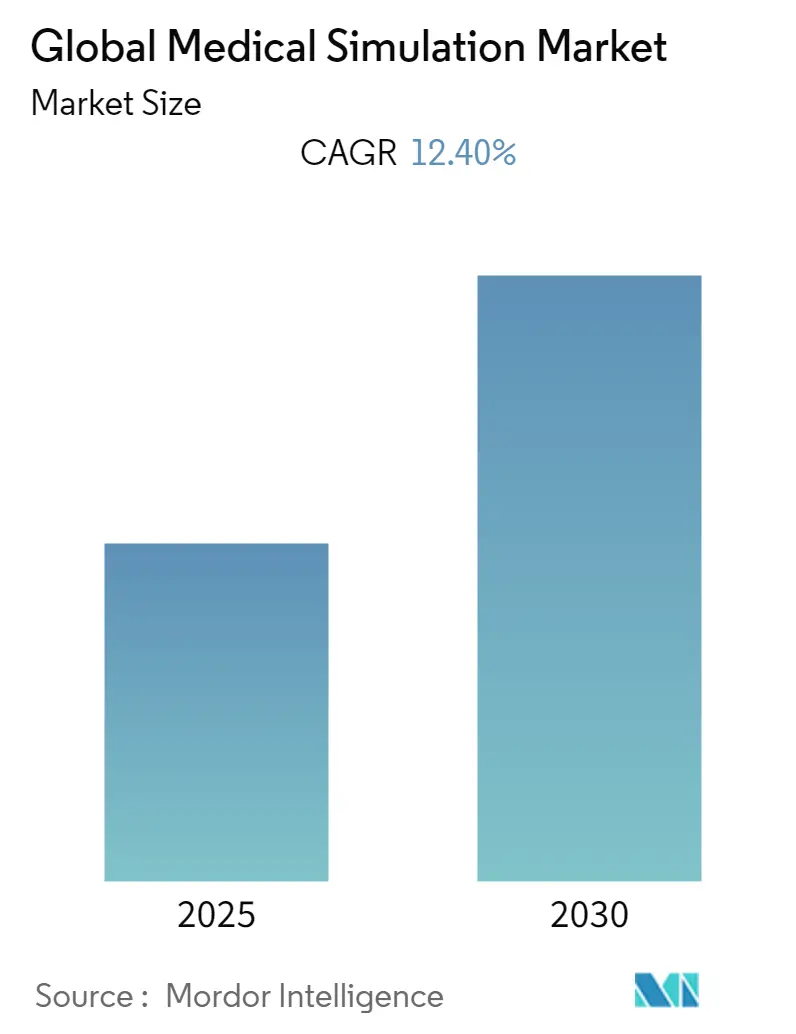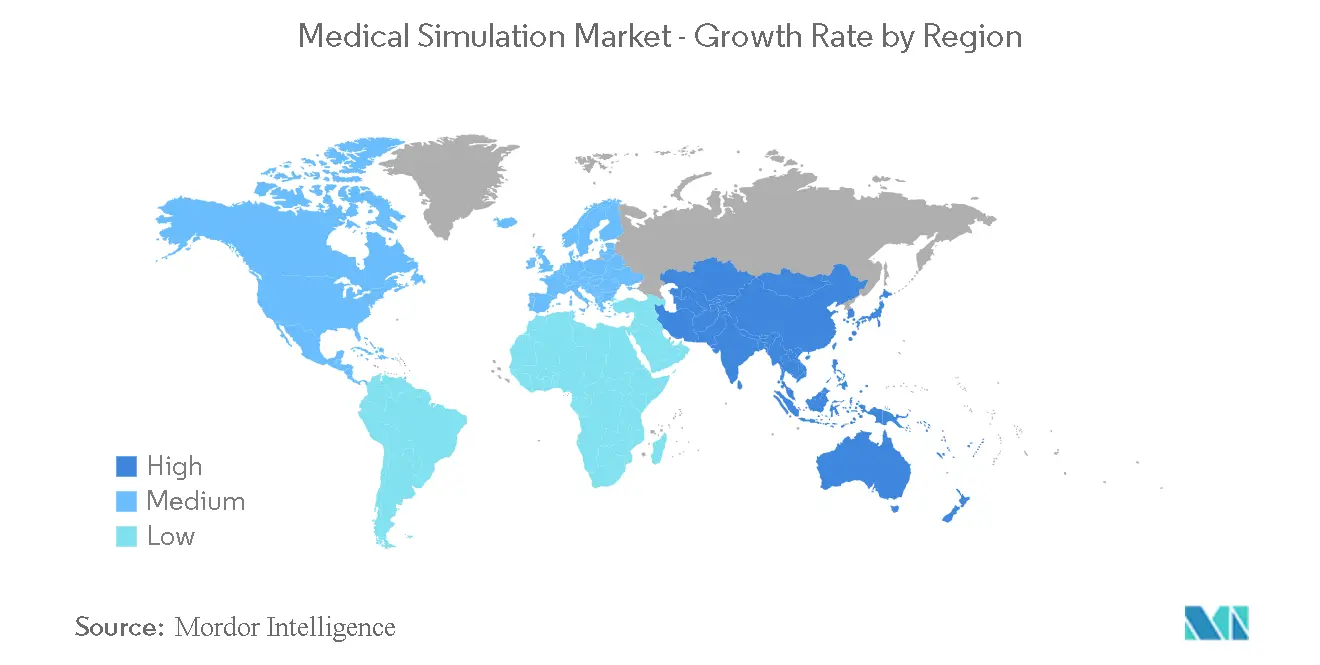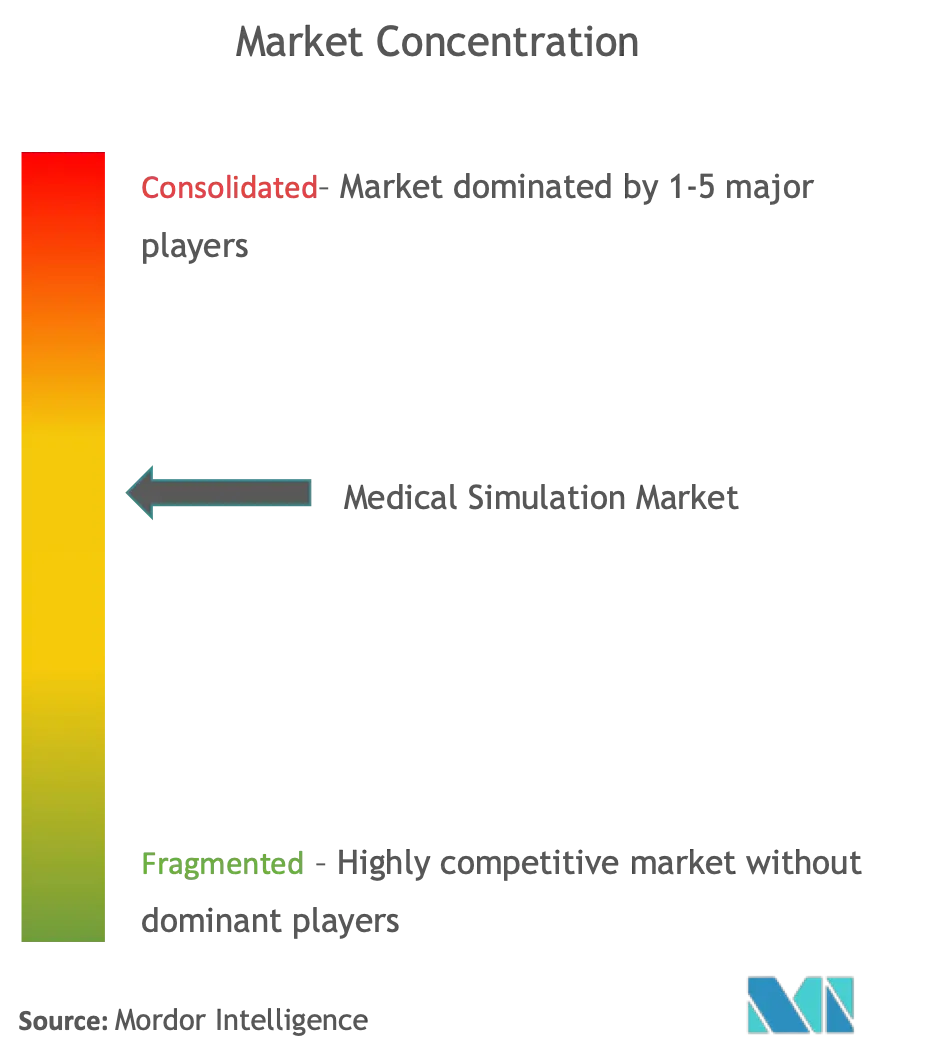Medical Simulation Market Analysis
The Global Medical Simulation Market is expected to register a CAGR of 12.4% during the forecast period.
Medical Simulation has played a critical role in response to the COVID-19 pandemic in various medical institutions. Simulation training is deployed at various healthcare institutions throughout the pandemic to refine protocols, facilitate practice changes, uncover safety gaps, and train redeployed healthcare workers in unfamiliar roles. According to the study titled "Implementation of Simulation Training During the COVID-19 Pandemic" published in the Stimulation Healthcare February 2021, in the process of responding to the pandemic, simulation was crucial. It was thought that simulation would be a good way to deal with system-based problems like identifying safety gaps, developing infection control strategies, and improving clinical management protocols due to its applications in disaster preparedness and crisis resource management. Thus, healthcare has increasingly adopted medical simulation during the pandemic in many ways showing that the pandemic has a positive impact on market growth.
The propelling factors for the growth of the medical simulation market include continuous technological advancements, increasing concerns over patient safety, and growing demand for minimally invasive treatments.
Technological advancement and innovation in health care facilities across the world have seen Minimally invasive surgery (MIS) grow as it is viewed as the most desirable surgical procedure for years now. MIS plays an essential role in general surgery as an alternative to traditional open surgery including laparoscopic techniques, cardiac surgeries, gynecology, orthopedic, etc.
According to the research article titled 'Comparison of Patient Preference, Understanding, and Sentiment for Minimally Invasive Versus Open Spine Surgery "published in Clinical Spine Surgery, February 2022, long-term outcomes, surgeon's recommendation, and complication risk were the most important criteria identified by patients when choosing between open and minimally invasive surgery (MIS). Patients also perceived MIS surgery to have advantages over open surgery in postoperative pain, complication risk, recovery time, cost, and anesthesia requirement. Most patients seem to prefer a minimally invasive approach to their treatment. Patients view MIS surgery more favorably than open surgery overall. Thus, a rise in the demand for MIS is anticipated to drive the medical simulation market.
Moreover, according to the study titled "Considering simulation training to ensure patient safety for expert anesthesiologists over the age of 60 in Saudi Arabia" published in the Indian Journal of Clinical Anaesthesia in July 2022, In Riyadh, Saudi Arabia, senior anesthesiologists are still actively involved in patient care and their duties, and they feel that simulation can help them recognize and address age-related problems in their work as medical professionals. Determining incompetence, enhancing skills, and assisting anesthesiologists in making plans for their future clinical careers. Therefore, as patient safety concerns increase, physicians may use medical simulation training as a crucial component of their careers, which will increase the demand for medical stimulation products and services. The use of medical simulation devices, along with standardized patient simulators, has gained rapid growth over the last few years, mainly due to increasing technological advancements and their adoption in the field of healthcare. The METIman simulator is found to be one of the most advanced and realistic simulators in recent times, developed by the CAE simulators. Thus, the rise in various technological advancements in the field of medical simulation is increasing the applications in healthcare to train healthcare professionals, and because of this, the growth of the market studied is expected to propel over the forecast period.
Medical Simulation Market Trends
Cardiac Surgical Simulators is Expected to Hold a Significant Market Share Over Forecast Period
Owing to the high prevalence of cardiovascular diseases (CVDs) around the world, the adoption rate of the cardiac simulator in hospitals, and research centers is continuously increasing due to the rising number of surgical and other treatment procedures. For instance, according to the July 2022 update of the Centers for Disease Control and Prevention, in 2020, about 20.1 million Americans of age 20 years and older had coronary artery disease (CAD) and it was responsible for about 382,820 deaths 2020 and hence, owing to the high prevalence and mortality due to the cardiovascular diseases, the demand for effective and advanced treatment is increasing globally, which is expected to drive the demand of the cardiac surgical simulators and segment is expected to have significant growth over the forecast period. Further, as per the article titled 'Heart failure (HF) in France: chronic heart failure therapeutic management and risk of cardiac decompensation in real-life setting', published in February 2020, in France, around one million persons would be affected by heart failure (HF); there are nearly 70,000 deaths related to HF, and more than 150,000 hospitalizations despite well-defined treatment management. Moreover, cardiac simulation has emerged as a feasible adjunct to surgical education and training for most specialties, and thus, with the high burden of CVDs, the studied segment is expected to grow over the forecast period.
In addition, there have been several innovative product launches by the key players in the market which is further increasing the adoption of these cardiac simulators making them more user and budget-friendly, this factor is also expected to boost the growth of cardiac surgical simulators. For instance, in March 2022, MedLern, a leading digital learning solution for hospitals and healthcare professionals, unveiled an innovative, online resuscitation training platform that does not require instructor oversight, and this online program, HeartCodeComplete is co-developed and powered by the American Heart Association and Laerdal Medical technology. Therefore, the high and increasing prevalence of CVDs coupled with the growing awareness regarding minimally invasive treatments and the rising number of hospitals worldwide is expected to propel the adoption of the cardiac surgical simulator. Thus, due to the above-mentioned reasons, the cardiac surgical simulator segment is expected to have significant growth over the forecast period.
North America is Expected to Dominate the Medical Simulation Market Over the Forecast Period
North America is expected to dominate the market for medical simulators over the forecast period. The factors such as the growing prevalence of chronic diseases that require surgeries, technological advancements, and the presence of major players in this region is expected to be the major contributor to the growth of medical simulator devices. For instance, according to a report published by the Public Health Agency of Canada in December 2021, the crude incidence rate per 100,000 persons aged 65 years and more for ischemic heart disease was 2,306.9 in men and 1,537 for women and chronic obstructive pulmonary disease was 1,750.6 in men and 1,411.4 in women. In addition, according to the Globocan 2020 report, the estimated cancer prevalence in Northern America region is expected to increase from 2.6 million cases in 2020 to 3.5 million cases by 2040 and hence, owing to the high burden of chronic diseases in the region, the adoption of medical simulators is expected to increase in the region over the forecast period.
Further, the growing adoption of minimally invasive surgeries in the region is expected to boost growth in the medical simulation market as simulation helps in getting hands-on for real surgical procedures. For instance, according to the research study published in November 2021, titled 'Trends in the Use of Minimally Invasive Adnexal Surgery in the United States', most women who undergo oophorectomy and ovarian cystectomy for benign causes receive minimally invasive surgery as fewer problems are linked to minimally invasive surgery than laparotomy. In addition, the major players in this region have launched several innovative products, which is boosting the adoption of these stimulating services and goods. For Instance, in October 2020, -GIGXR, Inc., a provider of the medical simulator immersive learning System for instructor-led teaching and training, launched the HoloPatient Remote and GIG Mobile for medical and nursing schools. Therefore, due to the aforementioned factors, the north American region is expected to hold a significant share in the medical simulation market over the forecast period.
Medical Simulation Industry Overview
The market is highly fragmented with many players. With many small and medium players, the competition is high. The market has been experiencing the entry of new players over the last few years, owing to the rising popularity of simulation technology. The existing players are differentiating on the basis of price, quality, and technology. some of the market players are 3D Systems, Canadian Aviation Electronics (CAE), Gaumard Scientific Company Inc., Kyoto Kagaku Co. Ltd, Laerdal Medical, Limbs & Things Ltd etc.
Medical Simulation Market Leaders
-
3D Systems Inc.
-
CAE Inc.
-
Gaumard Scientific Company Inc.
-
Laerdal Medical
-
Kyoto Kagaku Co. Ltd
- *Disclaimer: Major Players sorted in no particular order
Medical Simulation Market News
- In March 2022, MedLern, a leading digital learning solution for hospitals and healthcare professionals, unveiled an innovative, online resuscitation training platform that does not require instructor oversight. The globally proven, online program, HeartCode Complete is co-developed and powered by American Heart Association (Association) science and Laerdal Medical technology.
- In January 2022, Inovus Medical launched a new high-fidelity hysteroscopy simulator, HystAR. The simulator combines the company's patented augmented reality technology and cloud-based learning platform with the natural haptics of its simulated tissue models to deliver highly realistic, scalable, tracked hysteroscopy skills training.
Medical Simulation Industry Segmentation
As per the scope of the report, medical simulation is the modern-day methodology for training healthcare professionals through advanced educational technology. Medical simulation is experiential learning that every healthcare professional may need, but cannot be consistently engaged in during real-life patient care. The Medical Simulation Market is segmented by Products and Services (Products, Services and Software), Technology (High-fidelity Simulators, Medium-fidelity Simulators, and Low-fidelity Simulators), End User (Academic and Research Institutes, and Hospitals), and Geography (North America, Europe, Asia-Pacific, Middle East and Africa, and South America). The market report also covers the estimated market sizes and trends for 17 different countries across major regions, globally. The report offers the value (in USD million) for the above segments.
| By Products and Services | Products | Interventional/Surgical Simulators | Laparoscopic Surgical Simulators |
| Gynecology Surgical Simulators | |||
| Cardiac Surgical Simulators | |||
| Arthroscopic Surgical Simulators | |||
| Other Products | |||
| Task Trainers | |||
| Other Products and Services | |||
| Services and Software | Web-based Simulation | ||
| Medical Simulation Software | |||
| Simulation Training Services | |||
| Other Services and Software | |||
| By Technology | High-fidelity Simulators | ||
| Medium-fidelity Simulators | |||
| Low-fidelity Simulators | |||
| By End User | Academic and Research Institutes | ||
| Hospitals | |||
| Geography | North America | United States | |
| Canada | |||
| Mexico | |||
| Europe | Germany | ||
| United Kingdom | |||
| France | |||
| Italy | |||
| Spain | |||
| Rest of Europe | |||
| Asia-Pacific | China | ||
| Japan | |||
| India | |||
| Australia | |||
| South korea | |||
| Rest of Asia-Pacific | |||
| Middle East and Africa | GCC | ||
| South Africa | |||
| Rest of Middle East and Africa | |||
| South America | Brazil | ||
| Argentina | |||
| Rest of South America | |||
Medical Simulation Market Research FAQs
What is the current Global Medical Simulation Market size?
The Global Medical Simulation Market is projected to register a CAGR of 12.4% during the forecast period (2025-2030)
Who are the key players in Global Medical Simulation Market?
3D Systems Inc., CAE Inc., Gaumard Scientific Company Inc., Laerdal Medical and Kyoto Kagaku Co. Ltd are the major companies operating in the Global Medical Simulation Market.
Which is the fastest growing region in Global Medical Simulation Market?
Asia Pacific is estimated to grow at the highest CAGR over the forecast period (2025-2030).
Which region has the biggest share in Global Medical Simulation Market?
In 2025, the North America accounts for the largest market share in Global Medical Simulation Market.
What years does this Global Medical Simulation Market cover?
The report covers the Global Medical Simulation Market historical market size for years: 2019, 2020, 2021, 2022, 2023 and 2024. The report also forecasts the Global Medical Simulation Market size for years: 2025, 2026, 2027, 2028, 2029 and 2030.
Our Best Selling Reports
Medical Simulation Industry Report
The Medical Simulation Market is on a significant upswing, driven by the growing adoption of simulation technology in healthcare education and training. This market, segmented by products, services, technology, fidelity, and end-user, spans from academic institutions to military organizations. The surge in demand is fueled by the need for safer patient care, a preference for minimally invasive surgeries, and the advantages of simulation in healthcare, such as improved clinical skills and team coordination. Technological advancements, including high-fidelity simulators and virtual reality, are set to boost the market further. With healthcare infrastructure improvements and manufacturing facility expansions in emerging markets, the Medical Simulation Market is poised for continued growth, offering vast opportunities for market players. North America leads in revenue, thanks to key market players and technology investments, while the Asia Pacific region is expected to see remarkable growth due to healthcare infrastructure enhancements and a rise in medical simulation services. According to Mordor Intelligence™ Industry Reports, the market is experiencing robust growth, with detailed analysis and forecasts available in a free report PDF download, highlighting the market's potential for enhancing training solutions and patient safety outcomes in the healthcare sector.







